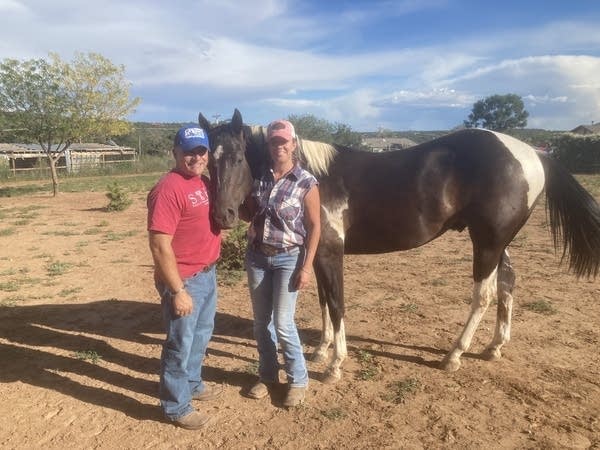
This wave of 40-year-high inflation feels different depending on where you live. It’s eating away at savings more quickly in rural parts of the country, where folks spend more on fuel, in particular, just to get to work, school and the grocery store. According to research from the University of Iowa, rising costs and slower-growing incomes cut small town households’ discretionary income by 38% in the last year, compared to a 17% drop for those in cities and suburbs.
To explore how this is playing out in my own rural community, the East Mountains outside Albuquerque, New Mexico, I stopped by a neighbor’s house to meet Buster, a mini horse who wears his reddish-brown mane in a braid and isn’t shy about asking for treats.
“He smells your apples,” one of his owners, Chris Morgan, said with a chuckle as Buster started to move into my personal space.
Chris works on a military base in Albuquerque, 40 miles west of Edgewood, New Mexico, where he lives with his wife, Tracy Tobyas, who works as a veterinary technician. They live here in the mountains in part so they can have horses in their lives. Buster’s barn mates include Roquefort, the baby and the newest addition, and Banjo, the old man of the group.

“He’s my therapist, he’s my best friend,” Tracy said. “The emotional attachment to him is just so strong.”
There’s also Tinker Bell, a rescued Clydesdale that Chris adopted after a deployment in Afghanistan.
“The first day that I got home and was able to go over to the farm, I walked out into the arena and her ears perked up and she came straight to me. She and I have been together ever since,” Chris said. “That’s my peace, that’s my spot. You know, some people go to the gym, some people [turn to] music, dancing. I get horseback.”
But over the last year or so, caring for these horses has gone from financially manageable to overwhelming. Tracy said feed costs have skyrocketed, particularly for her horses on special diets.
“Banjo is a geriatric senior horse who can’t chew hay effectively,” she said. “His pellets used to be, just earlier this summer, about $12 a 50-pound bag. Now it’s $18 a bag, and he eats two bags a week.”
So that increase adds up, and Tracy expects prices to rise further in the coming months. The cost of medicine, vet care and services like hoof trimming and teeth floating are also surging.
“It’s really stressful. I’m looking at possibly having to get a second job, and we’re definitely pinching pennies,” Tracy said.
Inflation has another of our neighbors, Sharon Lewis, taking a hard look at her work situation. She’s a massage therapist and she commutes 120 miles round-trip to her office in Santa Fe four days a week.
“Before gas prices started rising, one client a week was paying for my gas,” Sharon said. “But by summer of this year, I was now having to rely on two people a week to pay for the gas back and forth between Edgewood and Santa Fe.”
Sharon recently raised her prices slightly to help boost her bottom line, but said many of her clients are retirees on fixed incomes who can’t afford to pay much more. She has a home studio in Edgewood, where she’d like to book more appointments, but she said there’s a reason she typically commutes.
“It’s not quite as easy to reach people here” with advertising, she said. “And I have to take into consideration that there are not as many people that have disposable income in Edgewood as there are in Santa Fe.”
Particularly right now.
This is how that huge drop in small town households’ financial cushions starts to affect whole rural economies, said University of Iowa sociologist David Peters.
“People are gonna belt tighten, they’re gonna see, ‘Wow, we don’t have a lot of money left over every month,’” Peters said. So they don’t spend as much at local businesses like Lewis’ massage practice.
“Because they can’t really cut back on their driving to work or to get the kids to school or to go get groceries,” he said.
That inflexibility is what Stella Conklin wants city people to understand. She lives in Moriarty, 10 miles from the nearest grocery store and 17 miles in the opposite direction from her job as a county prosecutor, and she can’t just hop on public transit to reduce her fuel costs.
She’s got livestock, too: horses, chickens and a pot-bellied pig. It’s hard to cut back on those expenses. So, in her big household, it’s the food budget that’s taking a hit.
“There is food insecurity around here sometimes,” Stella said. “If you just happen to want to eat something here, you better hope the chickens laid in the morning sometimes. I mean, that’s just how it is.”
Stella already switched jobs this year for a higher wage, but it wasn’t enough to keep up with inflation. She’s putting off some home repairs and her retirement plans, and said she and her husband haven’t done much for fun lately.
“We don’t go to horse shows at all any more. It’s been a year since we’ve been to a horse show because there’s just no money. We very rarely even get to haul off property and go trail ride just because of the gas. And all these things that kind of give you quality of life,” she said, these things that make living in a rural place special, are slipping out of financial reach.










